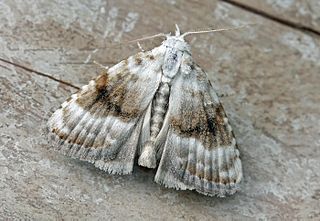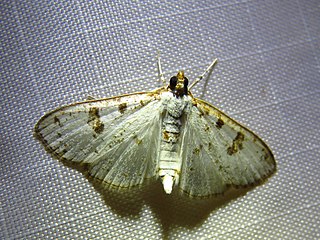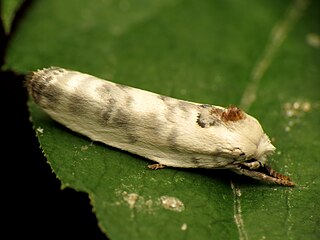
Meganola albula, the Kent black arches, is a moth of the family Nolidae. The species was first described by Michael Denis and Ignaz Schiffermüller in 1775. It is found in the Palearctic realm.

Meganola strigula, the small black arches, is a moth of the family Nolidae. The species was first described by Michael Denis and Ignaz Schiffermüller in 1775. It is found in Europe, Russia and Asia Minor.
Spilosoma latipennis, the pink-legged tiger moth, or the red-legged diacrisia, is a moth in the family Erebidae. It was described by Richard Harper Stretch in 1872. It is found in eastern North America, where it has been recorded from Georgia, Indiana, Iowa, Kansas, Kentucky, Maine, Maryland, New Brunswick, New York, North Carolina, Ohio, Ontario, Pennsylvania, South Carolina, West Virginia and Wisconsin.

Diacme adipaloides, the darker diacme moth, is a moth in the family Crambidae. It was described by Augustus Radcliffe Grote and Coleman Townsend Robinson in 1867. It is found in North America, where it has been recorded from Alabama, Arkansas, Florida, Indiana, Maine, Maryland, Massachusetts, Michigan, Minnesota, New Brunswick, New Hampshire, New Jersey, New York, North Carolina, Nova Scotia, Ohio, Oklahoma, Ontario, Quebec, South Carolina, Tennessee, Texas, Virginia, West Virginia and Wisconsin. Adults have been recorded year round.

Arogalea cristifasciella, the stripe-backed moth, is a moth of the family Gelechiidae. It is found in North America, where it has been recorded from Alabama, Arkansas, Connecticut, Florida, Georgia, Illinois, Indiana, Kansas, Kentucky, Louisiana, Maine, Maryland, Massachusetts, Michigan, Mississippi, Missouri, New Hampshire, New Jersey, New York, North Carolina, Ohio, Oklahoma, Ontario, Quebec, South Carolina, Tennessee, Texas, Virginia, West Virginia and Wisconsin.

Diastictis argyralis, the white-spotted orange moth, is a moth in the family Crambidae. It was described by Jacob Hübner in 1818. It is found in North America, where it has been recorded from Colorado, Florida, Georgia, Indiana, Maine, Maryland, Mississippi, North Carolina, Ohio, Ontario, South Carolina, Tennessee, Texas and Virginia.

Gymnandrosoma punctidiscanum, the dotted ecdytolopha moth, is a moth of the family Tortricidae. It is found in North America, where it has been recorded from Alabama, Arkansas, Florida, Georgia, Illinois, Indiana, Kentucky, Maine, Maryland, Massachusetts, Michigan, Minnesota, Missouri, New Jersey, New York, North Carolina, Ohio, Oklahoma, Ontario, Pennsylvania, Quebec, South Carolina, Tennessee, Virginia, and West Virginia.

Hyperstrotia secta, the black-patched graylet moth, is a moth of the family Erebidae. The species was first described by Augustus Radcliffe Grote in 1879. It is found in North America, where it has been recorded from Alabama, Arkansas, Florida, Georgia, Illinois, Indiana, Kentucky, Louisiana, Maryland, Massachusetts, Mississippi, New Hampshire, New Jersey, New York, North Carolina, Ohio, Oklahoma, South Carolina, Tennessee, Virginia and West Virginia.

Lacinipolia laudabilis, the laudable arches moth, is a moth of the family Noctuidae. It is found in the United States, where it has been recorded from Alabama, California, Florida, Georgia, Kentucky, Maryland, North Carolina, Oklahoma, Massachusetts, Pennsylvania, South Carolina, Tennessee, Texas and Virginia. It is also found in Mexico and Costa Rica. It has been recorded from Great Britain, where it was probably accidentally imported, but it might also be a rare immigrant.

Pococera expandens, the striped oak webworm moth or double-humped pococera moth, is a moth of the family Pyralidae. It is found in North America, where it has been recorded from Arizona, Arkansas, British Columbia, Georgia, Illinois, Indiana, Iowa, Kentucky, Louisiana, Maine, Manitoba, Maryland, Massachusetts, Mississippi, New Brunswick, New Hampshire, New Jersey, New York, North Carolina, Ohio, Oklahoma, Ontario, Pennsylvania, Quebec, South Carolina, Tennessee, Texas, Virginia, West Virginia and Wisconsin.

Polygrammodes flavidalis, the ironweed root moth, is a moth in the family Crambidae. It is found in North America, where it has been recorded from Alabama, Florida, Georgia, Illinois, Indiana, Iowa, Kansas, Kentucky, Maryland, Mississippi, Missouri, New Jersey, North Carolina, Ohio, Oklahoma, Ontario, Pennsylvania, South Carolina, Tennessee, Texas, Virginia, West Virginia and Wisconsin.

Palpita illibalis, the inkblot palpita moth, is a moth in the family Crambidae. It was described by Jacob Hübner in 1818. It is found in North America, where it has been recorded from Alabama, Florida, Georgia, Maryland, Mississippi, North Carolina, Ohio, Oklahoma, Pennsylvania, South Carolina, Tennessee, Virginia and West Virginia.

Antaeotricha leucillana, the pale gray bird-dropping moth, is a moth in the family Depressariidae. It was described by Philipp Christoph Zeller in 1854. It is found in North America, where it has been recorded from New Hampshire, Massachusetts, New York, Pennsylvania, District of Columbia, Virginia, North Carolina, Georgia, Alabama, Arkansas, Missouri, Kansas, Illinois, Iowa, Texas, Oregon, Louisiana, Manitoba and Nova Scotia.
Meganola varia is a species of moth in the family Nolidae and superfamily Noctuoidea. The species was first described by William Barnes and Arthur Ward Lindsey in 1921. It is found naturally in North America, where it has been recorded throughout Arizona, New Mexico, and western Texas. While some moths of its species have reportedly been photographed in California, Meganola varia is not found on the California Moth Checklist.
Meganola minor is a species of nolid moth in the family Nolidae. It is found in North America.
Meganola fuscula is a species of nolid moth in the family Nolidae. It is found in North America.

Meganola spodia, commonly known as the ashy meganola or Franclemont's meganola moth, is a species of nolid moth in the family Nolidae. It is found in North America.

Meganola minuscula, the confused meganola, is a nolid moth. The species was first described by Philipp Christoph Zeller in 1872. It is found in North America.
Meganola dentata, the toothed meganola moth, is a species of nolid moth in the family Nolidae. It is found in North America.
Meganola conspicua, the conspicuous meganola moth, is a species of nolid moth in the family Nolidae. It is found in North America.














